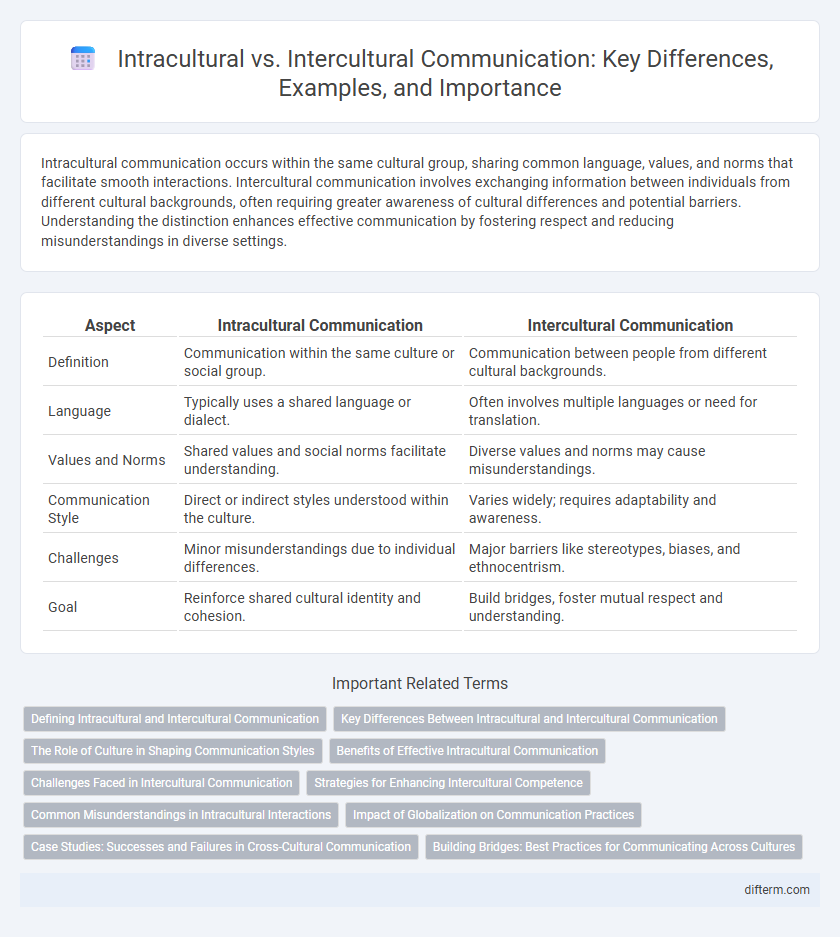Intracultural communication occurs within the same cultural group, sharing common language, values, and norms that facilitate smooth interactions. Intercultural communication involves exchanging information between individuals from different cultural backgrounds, often requiring greater awareness of cultural differences and potential barriers. Understanding the distinction enhances effective communication by fostering respect and reducing misunderstandings in diverse settings.
Table of Comparison
| Aspect | Intracultural Communication | Intercultural Communication |
|---|---|---|
| Definition | Communication within the same culture or social group. | Communication between people from different cultural backgrounds. |
| Language | Typically uses a shared language or dialect. | Often involves multiple languages or need for translation. |
| Values and Norms | Shared values and social norms facilitate understanding. | Diverse values and norms may cause misunderstandings. |
| Communication Style | Direct or indirect styles understood within the culture. | Varies widely; requires adaptability and awareness. |
| Challenges | Minor misunderstandings due to individual differences. | Major barriers like stereotypes, biases, and ethnocentrism. |
| Goal | Reinforce shared cultural identity and cohesion. | Build bridges, foster mutual respect and understanding. |
Defining Intracultural and Intercultural Communication
Intracultural communication occurs within a single cultural group, involving shared language, norms, and values that facilitate understanding and reduce misunderstandings. Intercultural communication takes place between individuals from different cultural backgrounds, requiring awareness of cultural differences, language barriers, and diverse communication styles to achieve effective interaction. Both types play crucial roles in global communication, with intracultural fostering cohesion and intercultural promoting cross-cultural exchange.
Key Differences Between Intracultural and Intercultural Communication
Intracultural communication occurs within the same cultural group, emphasizing shared norms, values, and language, which leads to smoother understanding and fewer misinterpretations. Intercultural communication involves interactions between individuals from different cultural backgrounds, often requiring heightened cultural awareness and sensitivity to overcome language barriers and differing communication styles. Key differences include the complexity of decoding messages and the potential for cultural misunderstandings, which are more prevalent in intercultural contexts than in intracultural exchanges.
The Role of Culture in Shaping Communication Styles
Culture profoundly influences communication styles by shaping values, norms, and expectations intrinsic to intracultural and intercultural interactions. Intracultural communication involves shared cultural contexts that foster implicit understanding and uniform communication patterns. Intercultural communication requires navigating diverse cultural frameworks, demanding heightened awareness and adaptive strategies to bridge differing communication codes and avoid misunderstandings.
Benefits of Effective Intracultural Communication
Effective intracultural communication strengthens social cohesion by promoting shared understanding and collective identity within a specific culture. It enhances collaboration and reduces misunderstandings among members who share common linguistic and cultural norms, leading to increased group productivity. Strong intracultural communication also supports cultural preservation and reinforces trust, facilitating smoother conflict resolution and deeper interpersonal relationships.
Challenges Faced in Intercultural Communication
Intercultural communication presents challenges such as language barriers, differing cultural norms, and nonverbal misinterpretations that can hinder effective interaction. Unlike intracultural communication, where shared cultural backgrounds facilitate understanding, intercultural exchanges require heightened cultural sensitivity and awareness to navigate diverse values and communication styles. Miscommunication in intercultural contexts often arises from ethnocentrism and stereotypes, necessitating strategies for active listening and empathy.
Strategies for Enhancing Intercultural Competence
Effective strategies for enhancing intercultural competence include developing cultural self-awareness, practicing active listening, and engaging in perspective-taking to understand diverse worldviews. Implementing targeted communication training that emphasizes cultural norms, nonverbal cues, and language nuances fosters deeper intercultural understanding. Encouraging immersive experiences and feedback mechanisms further cultivates adaptability and empathy in intercultural interactions.
Common Misunderstandings in Intracultural Interactions
Intracultural communication often faces misunderstandings rooted in assumptions about shared values and language use within the same culture. Misinterpretations arise when regional dialects, social norms, or generational differences are overlooked, leading to communication breakdowns despite cultural similarity. Recognizing these subtle intracultural variations enhances clarity and reduces miscommunication within a group sharing a common cultural background.
Impact of Globalization on Communication Practices
Globalization intensifies intercultural communication by increasing interactions among diverse cultural groups, necessitating enhanced cultural awareness and adaptability. Intracultural communication remains rooted in shared norms and values, but globalization introduces hybrid cultural influences that reshape these internal communication practices. Effective communication strategies must address both intracultural consistency and intercultural negotiation to navigate the complexities of the globalized communication landscape.
Case Studies: Successes and Failures in Cross-Cultural Communication
Case studies in cross-cultural communication reveal that intracultural interactions often benefit from shared norms and values, which reduce misunderstandings and enhance collaboration efficiency. In contrast, intercultural communication poses challenges such as language barriers, differing cultural etiquettes, and varying communication styles, which can lead to conflicts or misinterpretations if not managed properly. Successful intercultural cases demonstrate the effectiveness of cultural intelligence, active listening, and adaptation strategies in bridging gaps and fostering mutual respect among diverse participants.
Building Bridges: Best Practices for Communicating Across Cultures
Effective communication across cultures requires understanding intracultural nuances and recognizing differences in intercultural exchanges. Building bridges involves active listening, empathy, and adapting messages to respect cultural contexts and values. Leveraging cultural intelligence and fostering open dialogue enhances mutual understanding and collaboration in diverse environments.
Intracultural vs Intercultural Infographic

 difterm.com
difterm.com